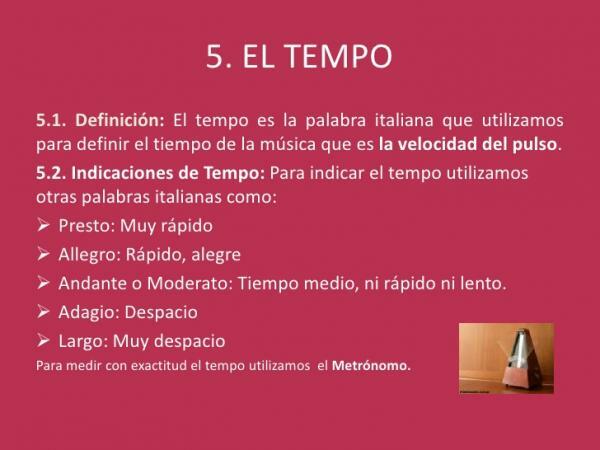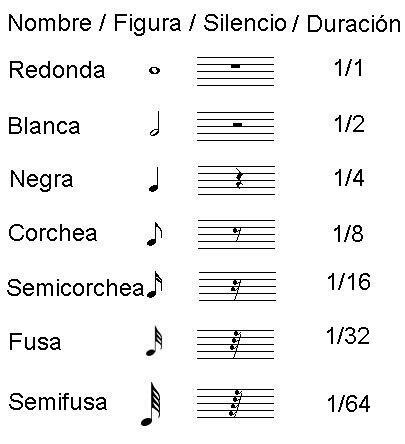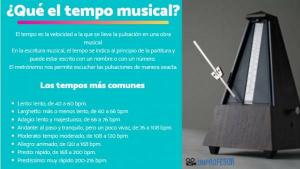What is musical TIME

Image: Slideshare
Sometimes there are so many elements and factors in music that if we are not used to seeing they cannot be confused or we simply ignore them. The truth is that each of these factors is part of the musical language that allows us to use this art to express ourselves. One of these very common elements is the musical time or tempo. In this lesson from a TEACHER you will learn the definition of time musical, of its importance and what role it has in music.
Index
- Meaning of musical tense
- What is BPM
- Types of musical time
- What is the role of time in music
Meaning of musical time.
Music is a multidimensional art. Based on the sound, the music plays with the vertical factor (the pitch) and horizontal factor (time, rhythm, speed, etc.)It is by combining these elements in a creative and successful way that we are able to obtain wonderful musical works.
When we talk about time in music we are referring to all those horizontal elements that have to do with basic characteristics of sound such as space
between the notes between them and their duration. For this we have a keyword that defines the concept we are looking for: tempo.The tempo is the speed at which we must interpret a musical work. In writing, the tempo is placed at the beginning of the score and can be indicated with a name or with a number. Today this measure is obtained thanks to an artifact called metronome what does the BPM.
What is BPM.
The BPM comes from english words "Beats per minute" y is the official measure of tempo. It can also be named in Spanish PPM indicating "beats per minute", but the English form is usually more universal. This way of measuring tempo indicates the number of “beats” or “beats” that sound within 1 minute. For this we must also take into account the musical figure, because depending on its duration, the speed would change even if the BPM is the same number.
The standard figure to use is generally the black, but it is also possible to indicate another, so pay attention to whether the BPM is accompanied by a base figure indication. If there is no specification, it is understood that the base figure is the black one.
For example, if it is indicated that the black = 60bpmThis means that there will be 60 quarter notes in 1 minute, the quarter note would equal 1 second. In another mode, if it is indicated that the white = 60bpm, this means that there are 60 half notes in 1 minute, and since the half half is twice as long as a quarter note, this would mean that the tempo is actually twice as fast.

Image: Slideshare
Types of musical time.
Taking into account the BPM, the tempo ranges can be classified and this comes historically from the classical music, where the tempos were standardized even not only in speed, but also in the character of the interpretation of a piece. With this it was inferred that a piece should not only be executed at a certain speed, but also with a determined intention and with certain expressive characteristics (for example sadness, majesty, vivacious, etc.).
This is how many ranges get a name to indicate the tempo. These are some of the tempos used:
- Larghissimo: extremely slow, less than 20 bpm
- Long: very slow, 20 bpm.
- Slow: slow, 40 to 60 bpm.
- Larghetto: more or less slow, 60 to 66 bpm
- Adage: slow and majestic, from 66 to 76 bpm
- Appetizing: 72 bpm.
- Walking: walking and calm, but a bit lively, from 76 to 108 bpm.
- Moderate: moderate tempo, 80 to 108 bpm.
- Allegretto: moderately animated.
- Allegro: lively and fast, from 110 to 168 bpm.
- Vivace: vivacious.
- Presto: very fast, from 168 to 200 bpm.
- Prestissimo: very fast, over 200 bpm.
- Allegro prestissimo with fuoco: extremely fast, over 240 bpm.

What role does time have in music?
Speed is a determining factor of how we perceive sound and therefore it is also a highly expressive element. While a slow piece can communicate calm or sadness, a very fast piece can express excitement or tension.
Now, in terms of practicality and playability, tempo is very important so that the musicians play with unity. For example, when we see the conductor in an orchestra waving the baton, one of his functions is to direct the tempo of the work, since it is common even that sometimes the time changes and must be accelerated or slowed down during the construction site.
Finally we can say that the established tempo of a work guarantees us that its expressive sense is maintained and therefore the message or motivation of the composer can remain as it was conceived.
Music is a form of communication that, as such, requires certain standards to function as a language so that we can convey its messages through it. When studying it, we must understand concepts that are part of its structure and that will allow us to express ourselves with it. Now that you know what is musical timeYou will have one more tool to be able to use this art as a means of communication.
If you want to read more articles similar to Definition of musical time, we recommend that you enter our category of Musical language.


